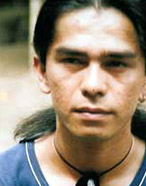 |
||
|---|---|---|
| CP Foundation | About CP Biennale | 2003 | 2005 | Contact Us | >||
           
|
||
|
Yusra's objects appear silent and quiet, born from some intense meditations. Some vivid questions are bound to exist within them. Ideas for his works are often based on the trivial, daily matters. Yusra dwells on the simple philosophy of life that he believes in. "When hardness meets hardness, it will be very difficult," he says. The hardness must therefore be softened. Yusra chooses nickel to represent the hardness. The nickel appears in this work as soft, dominant material, which also gives out some watery impressions. Yusra presents his symbolic objects with minute details. He has a keen sense on the nature and characters of the things and matters that he finds fit for expressing his thoughts and imaginations. When I went to his studio, I saw the various tools hanging and lying on the floor, on the table. Yusra works in his studio, creates models, assembles his objects, and molds, until the work fits with what he has sketched beforehand. Yusra generally do not create realistic forms. "Realistic forms are already there," he says. In the aesthetic intensity that he offers, the key is in the feeling, in the subjective mood and nuances. This is of course highly subjective and intuitive. Indeed, for Yusra, the important moment is when the audience views and touches his works - what kind of stimulus that emerges from that moment? There lies the hope for a dialogue of feelings. Yusra's objects represent the objects we see in our daily life, but they are aesthetically created and arranged. Having attained some higher aesthetic values, they naturally appear distinct from found objects in our daily life. In a similar way, they are also distinct from the artistic practices of creating works from these found objects. Yusra, therefore, has the full authority on the objects and matters he uses. A. Sudjud Dartanto Born on October 8th, 1973 in Padang Panjang. SELECTED GROUP EXHIBITIONS |
||
|
CP Foundation | About CP Biennale | 2003 | 2005 | Contact Us
Jl. Suryopranoto 67A, Jakarta 10160, Indonesia. ph. +62.21.3448126, 3853206 | fax. +62.21.3853203, 3853208 info@cp-foundation.org |
||
 While the world of contemporary art is keeping itself busy with sociopolitical themes, Yusra Martunus's works, abounding with artistic symbols and icons, appear as an antithesis. Yusra, a member of Kelompok Seni Rupa Jendela has indeed chosen objects and things as his focal interest. He studies the art of sculptures in ISI, Yogyakarta. "I've always enjoyed playing with objects ever since I was a kid," he says. The work displayed in this biennale, Melunakkan Keras (Softening Hardness), depicts a chunk of melting metal. The object was made of cast nickel mixtures. Yusra, an artist of Minangkabauan descent (the ethnic group from West Sumatra), portrays his thoughts and restlessness using the symbols and icons he creates from the objects.
While the world of contemporary art is keeping itself busy with sociopolitical themes, Yusra Martunus's works, abounding with artistic symbols and icons, appear as an antithesis. Yusra, a member of Kelompok Seni Rupa Jendela has indeed chosen objects and things as his focal interest. He studies the art of sculptures in ISI, Yogyakarta. "I've always enjoyed playing with objects ever since I was a kid," he says. The work displayed in this biennale, Melunakkan Keras (Softening Hardness), depicts a chunk of melting metal. The object was made of cast nickel mixtures. Yusra, an artist of Minangkabauan descent (the ethnic group from West Sumatra), portrays his thoughts and restlessness using the symbols and icons he creates from the objects.